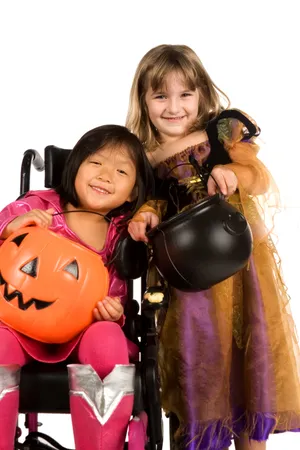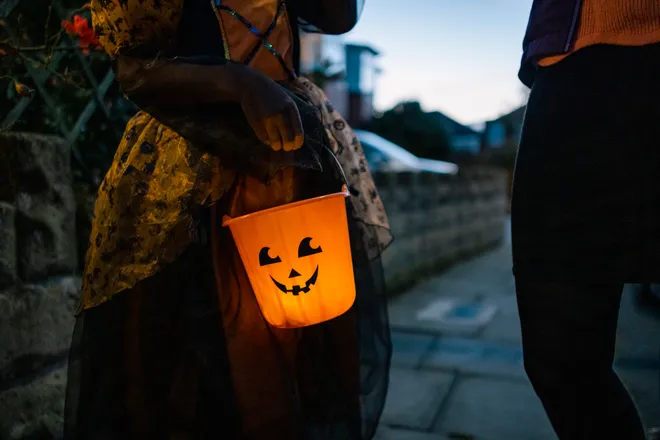Keep trick-or-treating accessible for all: a few simple tips for an inclusive Halloween

What goes hand-in-hand with Halloween more than pumpkins, black cats, witches or the color orange? Trick-or-treating, of course.
The tradition may go back as far as the 16th century and has been enjoyed by children and adults alike for decades, giving communities and neighbors a chance to interact while enjoying sweet treats, decorations, costumes and wholesome family fun.
While costumes (and candies!) have changed over the years, the point of the door-to-door festivities has remained the same: sharing the wealth and putting a smile on the faces of the kids ringing doorbells and the people answering them.
The spooky time of year is generally a fun and cheerful affair, but for some, the act of merrymaking poses challenges. All kinds of people enjoy Halloween, but some groups of people, like those with disabilities, are often forced to consider potential barriers that may hinder their ability to participate and enjoy all the day has to offer.
The good news is that there are a number of fairly easy accommodations we can make in anticipation of Halloween night to make sure our homes and neighborhoods are welcoming to people of all kinds. From simply changing your expectations to stocking up on a few extra dollar store items, here are some tips to keep your Halloween accessible, accommodating and inclusive.
Festive Halloween states:A spookier season: These 10 states are the most Halloween-obsessed in the US, survey shows
Why accessibility and inclusivity matter on Halloween

Accessibility and inclusivity are an important part of everyday life. According to the CDC, up to 1 in 4 American adults have some kind of disability. These include mobility disability (12.1%), cognition disability (12.8%), an independent living disability (7.2%), people who are deaf or hard of hearing (6.1%), vision disability or blindness (4.8%) or another self-care disability impacting the ability to do tasks like dressing or bathing (3.6%).
The 2019 U.S. Census reported that 4.3% of American children under 18 have a disability, with the most common type among children five years and older being "cognitive difficulty."
With so many people in the U.S. impacted by disability, it's important to remember that even if we personally are not a member of this community at any given time, at least one (but likely many more) of the friends, loved ones, family, coworkers or neighbors in our lives likely do identify as disabled.
While legislation such as the Americans with Disabilities Act (ADA) and changes in education, culture and representation have helped to make our country a more accessible and accommodating place, we still have a long way to go. (For example, people on disability benefits are unable to get married if they want to keep the benefits they rely on.)
Everyone has the right to enjoy themselves and there is no reason disabled people should be excluded from celebrating Halloween or any other holiday. Making often simple changes to accommodate others may not solve the bigger problems, but it sure can make celebrating special days easier and more fun for everyone.
Allergy-friendly Halloween treats:Want a candy bowl that's safe for all? Try these allergy-friendly Halloween treats
Make your house an accommodating spot for trick-or-treaters

There are plenty of cheap (or free) and simple ways to ensure your home is a welcoming and inclusive place for all merrymakers. Part of the joy of Halloween for many is watching trick-or-treaters show off costumes and happily skip away with their bounty, something that no one wants to miss out on.
"Trick-or-treating is a really fun part of Halloween for many kids and we don't want anyone to be left out of that," said Zoe Goss, director of advocacy at the Autistic Self Advocacy Network. "The important thing is to think through, 'if someone has a disability of some kind, am I putting barriers between them and this experience?'"
Stock allergen-friendly and non-food treats
Handing out candy is traditional but not always accessible. In many cases, people with different disabilities have comorbid allergies, food intolerances or dietary restrictions, meaning they are unable to consume food containing common allergens such as egg, soy, wheat, dairy, peanut, corn, or certain dyes.
Reported food allergies have also increased significantly in the general population over the last decade, meaning there are plenty of people out there who may appreciate an alternative.
"Not everyone can eat Halloween candy. Some kids have very bad food sensitivities or allergies or for other reasons, they can't do it," said Goss. "So having treats that aren't candy available can be really helpful, like little notebook sets or toys or something like that to make sure that people who can't eat the Halloween candy can still participate."
Stocking allergy-sensitive treats can solve this potential issue and result in some unique and fun alternatives. Food items don't have to be candy (fruit snacks and popcorn or pretzel snack packs are good options) and treats also don't have to be food. Keep other fun trinkets around the home to pass out to those who can't partake in edible treats, such as coloring sets, stickers or small toys. These can all be found through an easy trip to the dollar store.
Don't demand a "trick-or-treat" or "thank you"
While we often consider the shout of "trick-or-treat" to be a pinnacle part of, well, trick-or-treating, sometimes speaking up is not a simple task. It can be fun to see little witches, pumpkins and cowboys yelling out the phrase through a big smile, but the verbal exchange is not necessary and should not be forced to get those treats.
"Not everyone is able to say 'Trick or Treat' to you. If someone comes up to you and doesn't say it, it's okay to just give them the candy," said Goss. "You don't have to make them say that phrase because some people don't speak or some people have a lot of difficulties in social situations, it may just not happen."
Don't assume that someone is being rude or forgetting their manners if they don't speak with you out loud. Instead, meet them where they are and offer them same treats you offer all other visitors.
Welcome visitors of all ages
We often associate dressing up and going door-to-door with small children, but they certainly are not the only people to enjoy the tradition. In fact, trick-or-treating can and is a fun activity for many ages and is a great way to enjoy community with neighbors and localize.
"You may see trick-or-treaters who are older than you would imagine that most trick-or-treaters would be," said Goss. "These may just be people that are hanging on to this fun thing from their childhood, but it could also be people with disabilities who really enjoy participating in this still as young adults. So just we always encourage people to be accepting that people are different from each other."
Don't try to be the treat police (no one likes a party pooper!) and question why people of a certain age are participating or assume they are trying to abuse your kindness. Remember, fun is fun and everyone is entitled to it.
"Not every trick-or-treater is going to be the same. Rather than worrying that someone is trying to pull one over on you, just give them the piece of candy and it'll all work out," said Goss.
Keep treats in an easy-to-reach place
People of all ages, sizes and backgrounds live with mobility disabilities. Vision disabilities can also pose some difficulties for people looking to navigate the hectic nature of Halloween night. Stairs, elevated or unkempt terrain or poorly-lit areas can be among the things that prevent a disabled person from approaching your home.
"If there are stairs up to your house, then someone who's a wheelchair user or has other mobility disabilities may not be able to get up to your house," Goss explained. "So, coming down sitting on the first couple of stairs and setting up a little station there where people can just come up with you on the sidewalk, will make sure that that barrier is not there and everyone can access whatever it is you're giving out."
Keeping the area around your home well-lit and maintaining clear, clean pathways can make trick-or-treating safer for everyone. Likewise, setting up your giving station in a spot that is easy to see and access from the main road or sidewalk can help everyone enjoy the treats you have on offer.
Spooky savings:23 businesses offering Halloween discounts from DoorDash, Red Lobster, Chipotle, more
Presume competence
While it's important to consider the needs and limitations of others, it is not helpful to make assumptions about others' abilities or treat them differently. Be accepting but treat people with disabilities like you would anyone else (that means no baby talk, invasive questions, unsolicited touching, talking about them in front of them, etc.).
"Remember that you can't tell who does and doesn't have a disability just by looking," Goss advised. "So, if a kid comes up to you and is not saying 'Trick or Treat' (for example) you shouldn't assume 'Oh, well, they don't look like they have a disability to me, they're probably just being shy and I should get them to come out of their shell by talking.'"
It is not your job to police, try to "fix" or analyze the behaviors or needs of others. Instead, simply hand over the treats, treat everyone with respect and have fun checking out all the costumes.
"(A) person might have a disability and you don't really have a way to know. So, err on the side of being inclusive and welcoming and not pressuring people to do things that they may not be able to do," Goss shared.
Disclaimer: The copyright of this article belongs to the original author. Reposting this article is solely for the purpose of information dissemination and does not constitute any investment advice. If there is any infringement, please contact us immediately. We will make corrections or deletions as necessary. Thank you.



